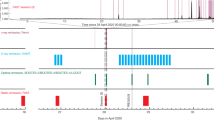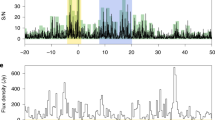Abstract
THERE are two mechanisms of current theoretical interest which might generate short ( <1 ms) radio pulses detectable at interstellar or even cosmological distances. In both cases the pulse is generated by the alteration of a magnetic field by an expanding conducting shell. The phenomenon might occur either as the expanding core of a supernova ‘combs’ the star's intrinsic dipole field1,2, or as the shell of charged particles emitted in the explosion of a primordial black hole (PBH) excludes the surrounding magnetic field3. In the latter case, the resulting radio pulse would, with suitable particle physics3,4, be much easier to detect than the γ-ray pulses that might also accompany the explosion5. The best published upper limit on the frequency of such γ-ray pulses is 4 × 10−2 events pc−3 yr−1 (ref. 6). We present here the results of a radio frequency search for isolated pulses, with much higher sensitivity than achieved previously. No definitive pulses have been detected, and the implied limit on PBH explosions is 2×10−9 events pc−3 yr−1.
This is a preview of subscription content, access via your institution
Access options
Subscribe to this journal
Receive 51 print issues and online access
$199.00 per year
only $3.90 per issue
Buy this article
- Purchase on Springer Link
- Instant access to full article PDF
Prices may be subject to local taxes which are calculated during checkout
Similar content being viewed by others
References
Colgate, S. A. & Noerdliger, P. D. Astrophys. J. 165, 509–521 (1971).
Colgate, S. A. Astrophys. J. 198, 439–445 (1975).
Rees, M. J. Nature 266, 333–334 (1977).
Blandford, R. D. Mon. Not. R. astr. Soc. 181, 489–498 (1977).
Page, D. N. & Hawking, S. W. Astrophys. J. 206, 1–7 (1978).
Weekes, T. C. & Porter, N. A. Proc. 12th ESLAB Symp. 375–378 (1977).
Meikle, W. P. S. & Colgate, S. A. Astrophys. J. 220, 1076–1086 (1978).
Jelley, J. V., Baird, G. A. & O'Mongain, E. Nature 267, 499–500 (1977).
Hulse, R. A. & Taylor, J. H. Astrophys. J. 201, L55–L59 (1975).
Manchester, R. N. & Taylor, J. H. Pulsars, 137–146 (Freeman, San Francisco, 1977).
Meikle, W. P. S. thesis, Univ. Glasgow (1973).
Lawless, B. G. thesis, Univ. College, Dublin (1971).
Colgate, S. A., McKee, C. R. & Blevins, B. Astrophys. J. 173, L87–L91 (1972).
Charman, W. N. et al. Nature 228, 346–348 (1970).
Charman, W. N. et al. Nature 232, 177–178 (1971).
Huguenin, G. R. & Moore, E. L. Astrophys. J. 187, L57–L58 (1974).
O'Mongain, E. & Weekes, T. C. Publ. astr. Sci. Pacific. 86, 470–476 (1974).
Dube, R., Groth, E. J., Rudnick, L. & Wilkinson, D. T. Nature phys. Sci. 245, 17–18 (1973).
O'Mongain, E. Nature phys. Sci. 242, 136–137 (1973).
Meikle, W. P. S. et al. Astr. Astrophys. 46, 477–478 (1976).
Author information
Authors and Affiliations
Rights and permissions
About this article
Cite this article
PHINNEY, S., TAYLOR, J. A sensitive search for radio pulses from primordial black holes and distant Supernovae. Nature 277, 117–118 (1979). https://doi.org/10.1038/277117a0
Received:
Accepted:
Published:
Issue Date:
DOI: https://doi.org/10.1038/277117a0
This article is cited by
-
A decade of fast radio bursts
Nature Astronomy (2018)
-
Science with ASKAP
Experimental Astronomy (2008)
-
Gamma rays and energetic particles from primordial black holes
Nature (1991)
-
Matter and antimatter in the same universe?
La Rivista del Nuovo Cimento (1989)
-
A systematic search for radio pulses associated with gamma-ray bursts
Astrophysics and Space Science (1981)
Comments
By submitting a comment you agree to abide by our Terms and Community Guidelines. If you find something abusive or that does not comply with our terms or guidelines please flag it as inappropriate.



